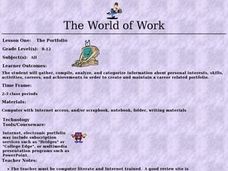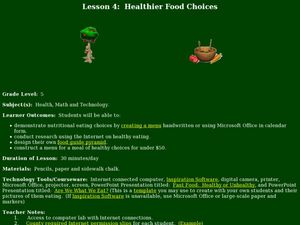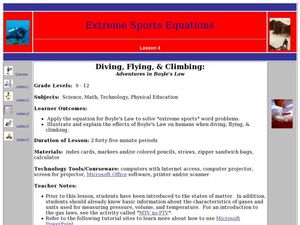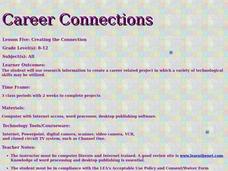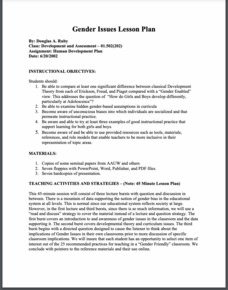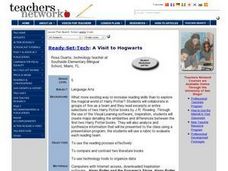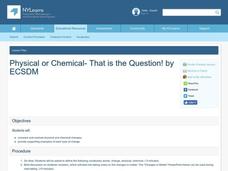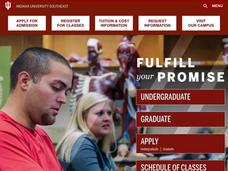Curated OER
The World of Work: The Portfolio
Students compile information to include in their career portfolio. In this portfolio lesson, students view example portfolios using the given website and identify the portfolio components. Students gather and compile artifacts for their...
Curated OER
Healthier Food Choices
Fifth graders create healthy menus. In this nutrition lesson, 5th graders research healthy eating options using the Internet, and design a personal food pyramid.
Curated OER
Career Connections
Students discover ways to use the Internet. In this Internet lesson, students complete an online tutorial and find ways to use toolbars and navigate using a browser. Students conduct an online scavenger hunt and find ways to...
Curated OER
The Renaissance Person: composing an Extended Definition Essay
Learners recognize the characteristics of an extended definition. In this Renaissance person lesson, students read a collection of short stories. Learners research the definitions of Renaissance and Renaissance person. ...
Curated OER
Diving, Flying, & Climbing
Students explore Boyle's Law. In this Boyle's Law lesson, students complete problems involving Boyle's Law. They examine the effects of Boyle's Law upon the human body. Students use the Internet to complete a lab activity.
Curated OER
Conversions Using English Units
Students explore the concept of English units. In this English units lesson, students convert from one English unit to another English unit. Students estimate the size and weight of objects using English units.
Curated OER
Career Connections
Pupils research information to create a career projects where technological skills will be utilized. In this career projects lesson plan, students create a project relating to a selected career of personal interest.
Curated OER
Literal Equations
Students explore Literal Equations. In this literal equations lesson, students use the Internet to connect to links and solve linear equations. Students investigate, analyze and record their findings on various activity worksheets.
Curated OER
Discovering the Journal of Augustus Pelletier
Students explore journals. In this Discovering the Journal of Augustus Pelletier lesson, students read the historical fiction book and conduct research activities to validate events in the plot that reflect the Lewis and Clark...
Curated OER
Get Your Facts Right!
Students explore the life and the contributions of Christopher Columbus. In this Exploration Age lesson plan, students participate in several activities regarding the explorer. Students use the Internet and print resources to...
Curated OER
Egg to Chick
Students become familiar with the parts of the egg. In this development of an egg lesson, students understand the difference between a fertilized and unfertilized egg. Students and view pictures, while they record changes in a fertilized...
Curated OER
The Water Cycle
Students conduct experiments involving different parts of the water cycle. In this water cycle lesson plan, students conduct five simple experiments to demonstrate how the water cycle works. The results of each experiment is discussed as...
Curated OER
Gender Issues Lesson Plan
Students examine gender biases. In this educational issues lesson plan, students participate in activities that require them to analyze gender issues in the classroom and challenge to break out of the mode.
Curated OER
Author Study (Chris Van Allsburg)
Third graders study a list of books written and illustrated by the author. They examine facts about the author's life. They take a survey of Allsburg's books read by the students using the Excel spreadsheet.
Cornell University
Beam Focusing Using Lenses
Explore optics using an inquiry-based experimental approach! Young scholars use a set of materials to design and build a unit capable of focusing a beam of light. They experiment with different lenses to determine the best approach to...
Curated OER
A Visit to Hogwarts
Students collaborate in groups to read excerpts or entire selections from two Harry Potter books, use educational software to create concept maps detailing similarities and differences between first two Harry Potter books, and analyze...
Curated OER
Physical or Chemical- That is the Question!
Students observe the differences between physical and chemical changes in properties. Through the use of an interactive presentation, the students compare and contrast the changes and provide supporting examples of each type of change.
Caucus 101
Linkage Institutions: Interest Groups: Option A
How are elections really run and won? Learn about special interest groups, super PACs, and lobbyists with an engaging lesson about the caucus process. Young voters research specific interest groups and analyze their part in previous and...
University of Colorado
Patterns and Fingerprints
Human fingerprint patterns are the result of layers of skin growing at different paces, thus causing the layers to pull on each other forming ridges. Here, groups of learners see how patterns and fingerprints assist scientists in a...
Channel Islands Film
Island Cattle Ranching
Is cattle ranching on Santa Rosa island viable or non-viable? Rather than focusing on the issues of the transition of Santa Rosa island from a privately owned island cattle ranch to a national park, class members are asked to consider if...
Alabama Learning Exchange
Researching Hurricanes with Technology
Students explain the components that make up a hurricane.
Curated OER
How Do You Get to School?
Third graders talk about all the various ways they get to school. They make a list of all the bus numbers that the students use. They also list all the other methods of transportation used and solidify a hypothesis.
Curated OER
Population Pyramids
Students explain the significance of population trends on world regions. They define relevant population vocabulary and examine age-gender patterns at various scales.
Curated OER
The African Slave Trade: From West Africa to South Carolina and Beyond
Eighth graders explore the African slave trade. They identify the principal figures practicing the African slave trades at three locations. Students draw the physical routes of the slave trade on a map and they list the reasons for the...
